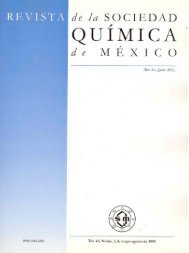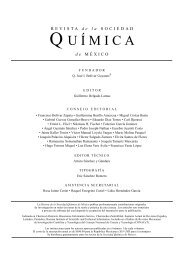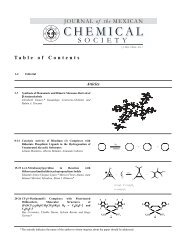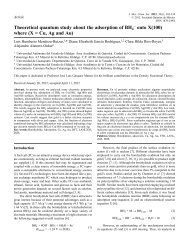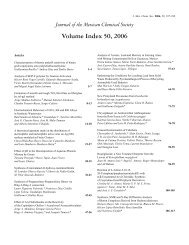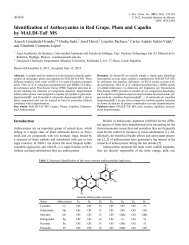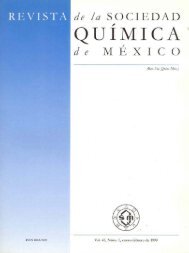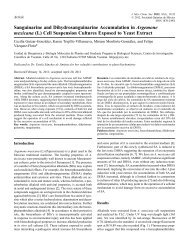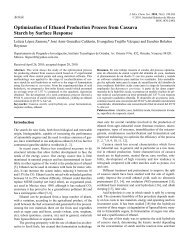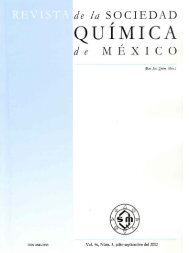SMQ-V047 N-002_ligas_size.pdf - Journal of the Mexican Chemical ...
SMQ-V047 N-002_ligas_size.pdf - Journal of the Mexican Chemical ...
SMQ-V047 N-002_ligas_size.pdf - Journal of the Mexican Chemical ...
You also want an ePaper? Increase the reach of your titles
YUMPU automatically turns print PDFs into web optimized ePapers that Google loves.
Revista de la Sociedad Química de México, Vol. 47, Núm. 2 (2003) 146-150<br />
Investigación<br />
Mechanism <strong>of</strong> Glutamate Neurochemistry: Electron Transfer<br />
and Reactive Oxygen Species<br />
Peter Kovacic 1 , Ratnasamy Somanathan 2* and Michelle Inzunza 1<br />
1 Department <strong>of</strong> Chemistry, San Diego State University, San Diego, CA 92182-1030, USA.<br />
2 Centro de Graduados e Investigación del Instituto Tecnológico de Tijuana, Apdo Postal 1166, 22000 Tijuana, B.C.<br />
México. E-mail: somanatha@sundown.sdsu.edu<br />
Recibido el 8 de abril del 2003; Aceptado el 3 de junio del 2003<br />
Dedicated to Pr<strong>of</strong>essor Alfonso Romo de Vivar<br />
Abstract. Glutamate (Glu) undergoes metabolism to an imine derivative.<br />
We propose involvement <strong>of</strong> <strong>the</strong> conjugated α-iminocarboxylic<br />
acid in neurotoxicity and possibly in neurotransmission. Electrochemistry,<br />
captodative effect and bioactivity <strong>of</strong> related cyclic α-imino<br />
acids are relevant. There is also consistency with background literature<br />
<strong>of</strong> Glu indicating participation <strong>of</strong> oxidative stress, reactive oxygen<br />
species, and electron transfer. Alternatively, metal chelates <strong>of</strong><br />
Glu and Glu imine may play a role. Various analogs <strong>of</strong> Glu imine<br />
were syn<strong>the</strong><strong>size</strong>d, namely, oxime and a cyclic model derived from<br />
cyclization <strong>of</strong> <strong>the</strong> intermediate hydrazone.<br />
Keywords: Glutamate, neurotransmission, toxicity, imine, electron<br />
transfer, reactive oxygen species.<br />
Resumen. El glutamato (Glu) se metaboliza a un derivado de imina.<br />
Se propone la inclusión del ácido iminocarboxílico conjugado en la<br />
neurotoxocidad y posiblemente en la neurotransmisión. La electroquímica,<br />
el efecto captodativo y la bioactividad del los ácidos α-<br />
imino-cíclicos son relevantes. Los hallazgos son consistentes con los<br />
antecedentes de la literatura que indican la participación de Glu en el<br />
estrés oxidativo, en la química de las especies reactivas de oxígeno, y<br />
en la transferencia electrónica. Alternativamente, los quelatos metálicos<br />
de Glu y de iminas Glu, juegan un papel importante. Varios análogos<br />
de imina Glu fueron sintetizados, en particular la oxima, y un<br />
modelo cíclico derivado de la ciclización de la hidrazona intermediaria.<br />
Palabras clave: Glutamato, neurotransmisión, toxicidad, iminas,<br />
transferencia electrónica, especies reactivas de oxígeno.<br />
Introduction<br />
During <strong>the</strong> last score <strong>of</strong> years extensive evidence has accumulated<br />
in support <strong>of</strong> involvement <strong>of</strong> oxidative stress (OS) with<br />
both endogenous and exogenous agents, including anti-infective<br />
drugs [1], anticancer agents [2], carcinogens [3], reproductive<br />
toxins [4], nephrotoxins [5], hepatotoxins [6], and various<br />
o<strong>the</strong>rs [7a].<br />
The most common reactive oxygen species (ROS) are<br />
superoxide, hydrogen peroxide, peroxyl radicals, and <strong>the</strong><br />
important hydroxyl radical, that are generated by electron<br />
transfer (ET). ET functionalities comprise quinones (or precursors),<br />
metal complexes (or chelators), aromatic nitro compounds<br />
(or reduced products), and imines (or iminiums),<br />
which on redox cycling with oxygen give rise to ROS. The<br />
present article will focus on <strong>the</strong> conjugated imine category. In<br />
some cases, ET occurs without oxygen participation. Very<br />
many bioactive substances or <strong>the</strong>ir metabolites incorporate ET<br />
groups. OS can produce beneficial results, as with drugs, or<br />
unwanted side effects in toxicity. The mode <strong>of</strong> action is usually<br />
complex and probably multifaceted in many instances.<br />
This report deals with <strong>the</strong> mode <strong>of</strong> action <strong>of</strong> glutamate<br />
(Glu), both in neurotransmission and in toxicity. We propose<br />
that <strong>the</strong> α-imino metabolite may play a role as an ET agent in<br />
<strong>the</strong>se processes. Glu metabolism, generation <strong>of</strong> ROS and prior<br />
literature on bioactivity <strong>of</strong> related α-iminocarboxylic acids<br />
lend support to <strong>the</strong> <strong>the</strong>sis. Several syn<strong>the</strong>tic analogs, both<br />
acyclic and cyclic, <strong>of</strong> <strong>the</strong> α-imino metabolite were syn<strong>the</strong><strong>size</strong>d.<br />
Metabolism<br />
In relation to mechanism, Glu metabolism has attracted scant<br />
attention even though metabolites <strong>of</strong>ten play an important role<br />
in physiological activity. It is significant that Glu can serve as<br />
substrate for an enzyme that effects conversion to <strong>the</strong> imine<br />
derivative (1a), particularly since Glu dehydrogenase plays a<br />
central role in amino acid deamination because in most<br />
organisms Glu is <strong>the</strong> only amino acid that has an active dehydrogenase<br />
[8].<br />
The labile product (1a) can undergo several subsequent<br />
conversions. Nucleophilic attack by a basic primary amino<br />
O<br />
OH<br />
a.) R= H<br />
1<br />
NR<br />
HO<br />
b) R= Substituent<br />
O




